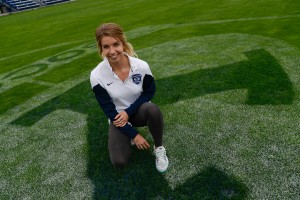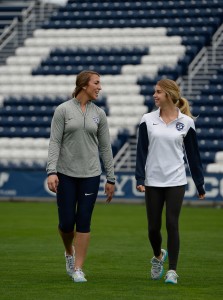
SALT LAKE CITY — The effects of a new, lower age for Mormon missionaries rippled through college women’s sports in Utah as players departed to serve, and now three years later many are returning to the field and making their presence felt.
Paige Hunt was a halfway through her first season at the soccer team at Brigham Young University when The Church of Jesus Christ of Latter-day Saints in 2012 lowered the minimum age to depart on missions from 21 to 19 for women.
Despite helping the team reach the Elite Eight of the NCAA Tournament, Hunt decided to take an 18-month hiatus and embark on a church mission.
Her coaches “were kind of blindsided,” Hunt said.
The team was already losing eight graduating seniors and had another key player who was injured.
Hunt postponed her mission for a year at the request of BYU women’s soccer coach Jennifer Rockwood and earned all-conference honors in 2013.
She then served a mission in Indianapolis and returned for this year’s season, sliding back into her starting position with the team.
With the missionary age change, every Division I school in the state has felt the effects, adjusting their strategies and recruiting as key players have departed on missions, The Salt Lake Tribune reported.
“We didn’t realize it would have as big of an impact on us as it did,” Rockwood said.
She has five players out on missions right now and a sixth leaves in a month.
The change in the minimum age, the first since 1960, sent ripples across Mormon culture and affected college enrollments and more. It’s sharply felt in Utah, home to about 1.9 million Mormons and the church’s worldwide headquarters.

Though young Mormon men are expected to serve missions, it is not required. Traditionally, there’s been less of an expectation for women to service missions, with many choosing to marry and start families before reaching the required age of 21.
Now that women can go on missions at 19, the number opting to do so has shot up.
Before the age change, most college female athletes waited until they were no longer eligible to play before embarking on a mission, Brigham Young University head women’s volleyball coach Heather Olmstead said.
Olmstead said that BYU, which is owned by the LDS Church, supports missions but is trying to adjust and work out with the players how to make the missions trips work for them and the school.
“Everyone is learning how to deal with it,” Olmstead said.
Kate Stringfellow, a University of Utah senior who competes on the track and cross country teams, said she came back in February from her mission and found that while her athletic scholarship was intact, she wasn’t in peak shape.
Rachel Boaz, the starting goalkeeper on BYU’s soccer team, said she faced a similar situation after returning in December.
“I lost a lot of muscle, and it took months to get my strength back,” Boaz said, “but it was the best decision I’ve ever made.”




